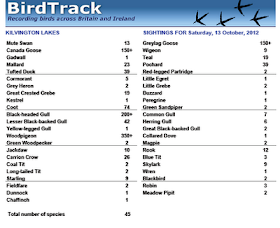This is hardly surprising as the news from Spurn on the Yorkshire coast, as reported on the BTO blog, was that there were over 21,000 Redwing, 10,000 Blackbird, 9,000 Fieldfare, 800 Song Thrush, 57 Ring Ouzel and 10 Mistle Thrush on the 22nd. With these kind of numbers being reported it is likely that Waxwings will be following and I noticed that RBA had alerts for Waxwings in Forth, Burnham Market, Brancaster Staithe, King's Lynn, Bacton and Cley Norfolk, Kilnsea, Tickton and Flamborough East Yorks, Lothian, Cleveland, Sussex, Fife and Lancs. So there may be a good chance of Waxwing being found in Notts during the week. I have not managed to get any decent photos of Waxwings in Notts for the past couple of years. I took the one below near Attenborough a couple of years back.
A friend has been birding along the North Norfolk coast today in what, he described as, 'Nasty weather with high winds, freezing temperatures and a hailstorm on the hour every hour.' He reported 5 000 Starlings over Hunstanton at dusk. 200 Fieldfare along the coast with at least 100 each of Redwing, Fieldfare and Robin. There has been over a dozen Ring Ouzel also reported. Last weekend I had no Fieldfare, Redwing or Ring Ouzel!
There has also been a conspicuous wreck of Little Auk along the east coast today and my mate had two Sabine's Gulls off the Coast at Titchwell in a ten minute seawatch...that's all he could stand in the shocking weather.
This Little Auk was in North Haven, Fair Isle this time last year. It's another one of those photos that is pin sharp on my PC but all fuzzy when I upload onto the blogger site. I've still no idea why this is the case. Still, should be some exciting birding during the next couple of weeks.


.jpg)


























.jpg)
.jpg)
.jpg)
.jpg)
.jpg)








.gif)
.gif)
.gif)
.gif)
.gif)
.gif)